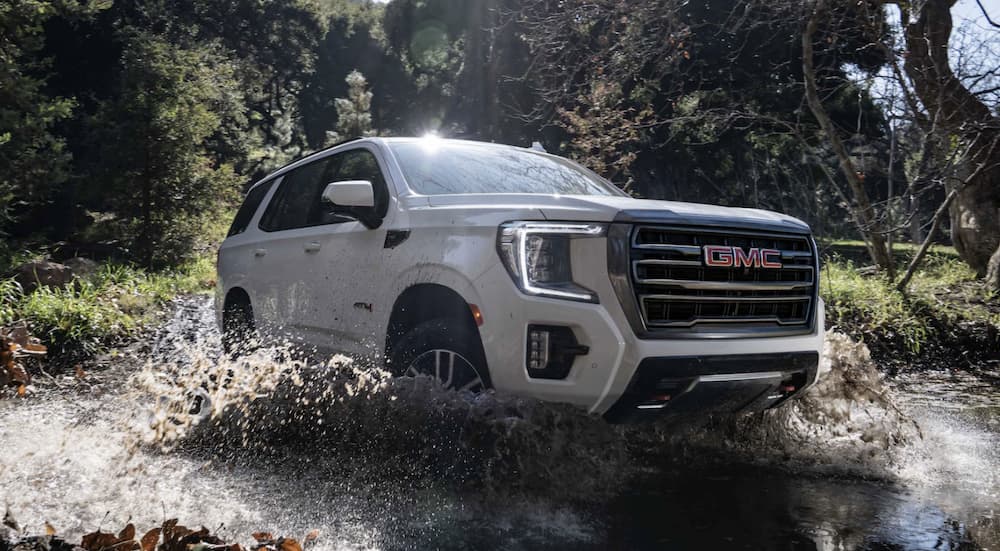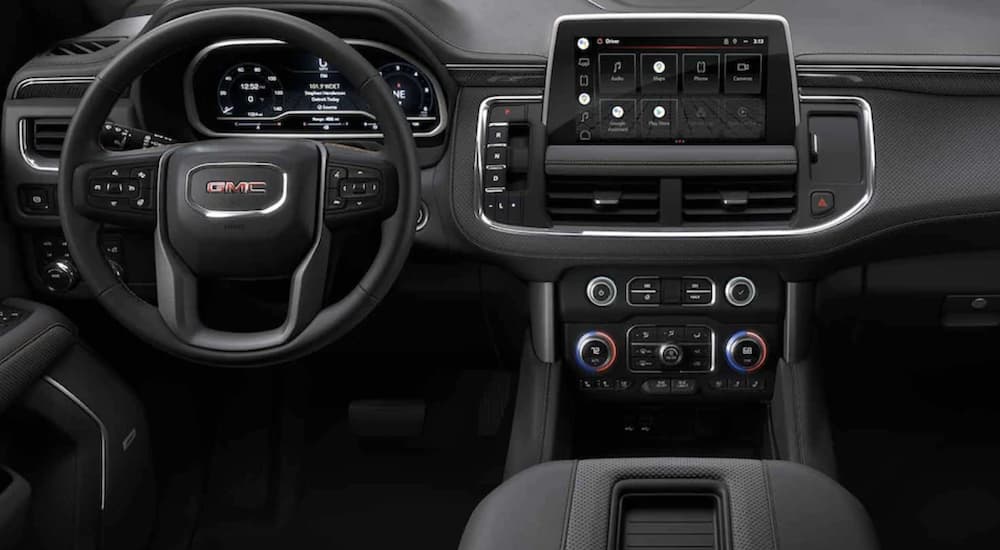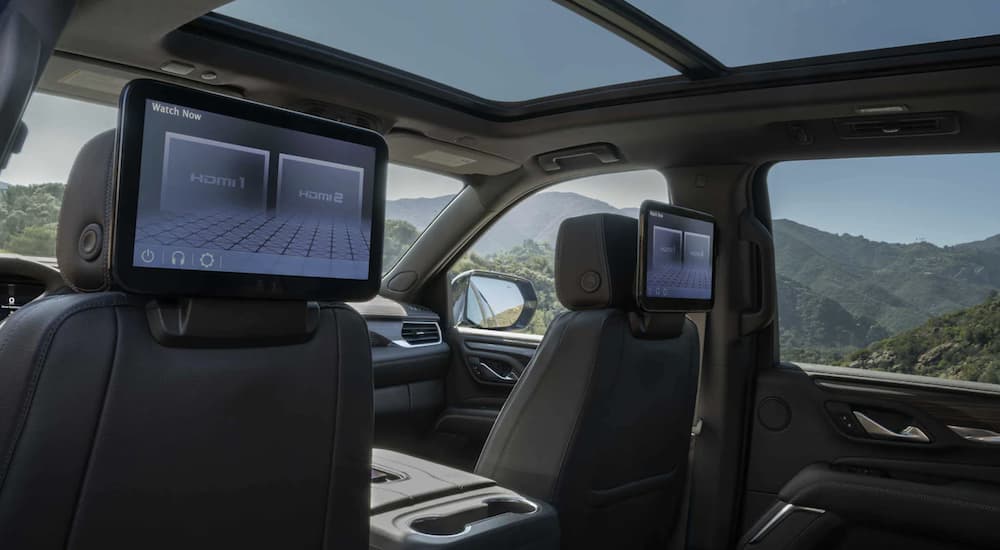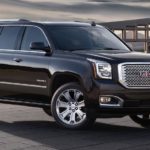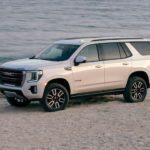Infotainment is big business in the world of the automotive industry. It used to be second-tier guesswork and forgettable features in the yesteryears; afterthoughts by consumers who maybe were only concerned about radio, CD, or MP3 players. But in recent times, the infotainment accouterments have taken on a life of their own. It’s not just about fancy stereo systems and large speakers anymore. In fact, some of the most talked-about features for vehicles these days happen to be associated with infotainment, from smartphone integration to wireless charging. But some brands are taking it a step further, evolving and upgrading with higher-end operating systems from big-name tech companies like Google. In fact, that’s what several of GM’s full-size vehicles are doing, including the 2022 GMC Yukon.
GMC engineers revamped the infotainment suite for the 2022 Yukon, and not just by adding a few bells and whistles; they really dug into the software and expanded it for the end-user. The Yukon, like a few of its other full-size siblings from GM, has been outfitted with a number of interesting new additions. At the heart of the upgrade is all-new Google technologies built directly into the electronic ecosystem of the vehicle and made standard across the entire 2022 Yukon trim line.
Google Built-In Is More Than Just Entertainment
Typically this section might have been located further down after talking about all the basic infotainment goodies that come with the new model year vehicles like the Yukon, but we’re doing things differently here. The main reason is that the Google Built-In, the name of the new suite, does more than just provide you with easier access to entertainment.
While being able to stream media, access your favorite tune, listen to your favorite podcast, or watch your favorite media is made easier than ever with the Google suite, it’s also about incorporating more informational and maintenance-related accessibility for the end-user as well. How does that work? Well, you can now use voice-activation through the Bluetooth wireless functionality to talk to the Google Assistant for all sorts of ready-to-answer questions and queries.
Much like Microsoft’s Cortana, or Apple’s Siri, you can access the Google Assistant by simply talking to it. Once the voice-activated cue has been triggered, you can then request the AI assistant to carry out a number of tasks, including accessing tons of vehicle-related information. You can check out how much fuel you have, you can inquire about the engine temperatures, and you can ask for travel details.
This also ties into accessing emergency services, travel routes, safety measures, and more. You have complete access to nearly every aspect of the vehicle that is monitored by electronic sensors. This adds a whole new level of interactivity and information for the end-user and certainly raises the perceived value of the infotainment suite by a significant margin for those who find such features useful.
Old Tech With A New Purpose
Voice-activated control mechanisms and informational requests are nothing new. Ever since voice activation became a big thing with the standardization of Bluetooth wireless connectivity in vehicles, car shoppers and tech enthusiasts have been able to make use of such features in newer vehicles. It makes it easy to access everything from media to telematics. However, in the case of the Google Built-In suite, it’s not necessarily brand new tech; it’s just brand new for newer model year vehicles.
Google’s Built-In initiative has been around for years, most notably for use with their initiatives like Chromecast, which utilizes technology to cast streaming media to other devices. In the case of the Google Built-In system for the 2022 GMC Yukon, it’s more than just being able to access media or connect smart devices to the vehicle. You can also access Google-compatible smart home devices from the vehicle, make use of navigational features to reach your destination, or access content directly from your smartphone.
Basically, we’re seeing a cross-functional ecosystem being utilized in vehicles like the 2022 GMC Yukon to get the most out of the software, the hardware, and the firmware. The added synergy between vehicle functionality, home functionality, and software accessibility probably won’t go over well with those who are averse to electronics taking over their vehicles, but it’s the way of the future. Certain brands are embracing this future more than others, and GMC happens to be one of them.
Connected Access For Easy Entertainment
If you have a Google account and a Google Assistant at home, you can pair up and synchronize your devices through a single Google account. Do you need a Google account for synchronization? Yes. Do you need a Google account to simply access the features available within the Yukon for the Google Built-In suite? No. You can still make use of a number of vehicle health reports and entertainment apps without a Google account.
However, the benefit of synchronizing your accounts across the diverse ecosystem of home and travel life is that you can personalize the experience the way you want. Much like your smartphone, the Google Built-In suite allows you to rearrange the apps you want, where you want them, to download and access all compatible apps available from the Google Play store, and to access settings for said apps to have them function the way you want. It’s essentially turning your full-size Yukon into a personalized extension of your smartphone. Assuming that’s something you want to do.
Other features that keep you informed or entertained include the standard implementation of Google News, as well as easy access to podcasts, streaming media, and vehicle settings as well. You can alter the temperature within the cabin, change the volume, and even monitor and control some of the trailer settings utilizing the all-new digital information cluster.
Voice Controls, Classic Controls, and Reminders
We’ve talked a lot about voice-activated controls, but for the old-school drivers out there, it’s entirely possible to make use of the classic steering wheel-mounted or touchscreen controls available with the infotainment suite. It may seem a little more cumbersome to make use of such controls, but if you’re driving around while the baby is sleeping in the back or there’s a lot of chatter going on with the passengers, it’s much, much easier to access what you want using the push-button or touchscreen controls rather than trying to shout over others.
However, there is an added benefit with the voice controls over the standard controls. This includes the ability to set reminders, schedule dates, and even plot destinations by accessing the voice-activated Google Assistant. You can have Google remind you about an appointment at a specific date and pull up a preset navigation point to your destination using Google Maps, which is actually built-in to Google Built-In (pun intended).
The Future of Infotainment
Obviously, some people are probably wondering what the catch-22 is with such a system? “It sounds too good to be true. It can’t be free!” and alas, there is a catch, and it does require a subscription to a data plan if you want to access all of the network-connected features. Of course, if you don’t want or need all of the navigation, online services, or network-related features outside of accessing data or media on your phone, you don’t need to subscribe to the extras. But for people who want it, it’s there.
Interestingly, Volvo also offers the Google Built-In suite, but it’s mostly attached to that brand’s electric and hybrid line-up, which severely limits the accessibility for those who want a classic combustion-powered vehicle. On the upside, the 2022 GMC Yukon is one of a few GM vehicles that offer the Google Built-In suite, and you’re not limited to an electric or hybrid-only setup to access it. Whether or not you see that as more or less appealing is up to you.
